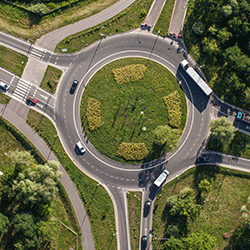
If you think there are more roundabouts on the roads where you drive, it is not your imagination. Despite some initial resistance in the U.S., the roundabout concept has blossomed and they are here to stay.
A roundabout is a circular roadway at an intersection in which road traffic travels in one direction around a central island.
Roundabout Benefits
Roundabouts improve traffic flow and reduce accidents. According to research by the Federal Highway Administration and the Insurance Institute for Highway Safety, roundabouts result in a 37 percent reduction in overall collisions and a 75 percent reduction in injury collisions. They also reduce fatality collisions by roughly 90 percent. Roundabouts virtually eliminate some of the most serious accidents, such as right-angle, left-turn and head-on collisions.
Another benefit is fewer delays on the road. Roundabouts handle traffic more efficiently than signalized intersections. At a roundabout, traffic yields rather than stops at either a sign or a light. With traffic constantly moving and vehicles entering the intersection at lower speeds, more vehicles can move through the intersection.
Types of Roundabouts
Roundabouts come in many shapes and sizes in the U.S. Single- and double-lane types are the most prevalent, with double-lane types found more in areas with heavy traffic. There are oval-, teardrop-, peanut- and even dog bone-shaped roundabouts. Some have as few as three legs; others have six legs. According to the U.S. Department of Transportation (DOT), regardless of size, shape or number of legs, the fundamental characteristics of all roundabouts include:
- Counterclockwise Flow—Traffic travels counterclockwise around a center island
- Entry Yield Control—Vehicles entering the roundabout yield to traffic already circulating
- Low Speed—Curvature that results in lower vehicle speeds, usually 15-25 MPH, throughout the roundabout
Even though roundabouts have proven to be a safer and more effective type of intersection, because they may be unfamiliar to most people, successful implementation of a roundabout requires extra outreach and education. Here are some do’s and don’ts for roundabout safety.
Do:
- At the dashed yield line, look to your left and yield to drivers already in the roundabout
- In a multilane roundabout, you must yield to both lanes of traffic; stay in your lane; do not change lanes
- Once a gap in traffic appears, merge into the roundabout and proceed to your exit
- Look for pedestrians and use your turn signal before you exit
Don't:
- Don’t panic
- Don’t enter a roundabout without sufficient prior observation to determine the best approach and optimal speed for entering
- Don’t stop in the roundabout—there is no stopping, only yielding
- Don’t assume the rules are the same for smaller or mini-roundabouts
- Don’t make impulsive decisions when in doubt
Entering and Leaving a Roundabout
As with any intersection, it is important to approach a roundabout with safety in mind. Decrease speed when approaching a roundabout and follow any posted speed signs. As you approach a single-lane roundabout, you will see a yellow "roundabout ahead" sign with an advisory speed limit posted.
In a multilane roundabout, you will see two signs as you approach the intersection: The yellow "roundabout ahead" sign and a black-and-white "lane choice" sign. You will need to choose a lane before entering the roundabout. Choose which lane to enter based on which direction you want to exit. To go straight or right, get in the right lane; to go straight or left, get in the left lane. Drivers can also make U-turns (proceeding all the way through the roundabout and into the exact opposite direction from which you entered the roundabout) from the left lane.
Once you have selected your lane, watch for pedestrians in the crosswalk as you approach the roundabout. If there are no vehicles immediately approaching, it is legal to proceed into the roundabout without stopping, as long as you follow all traffic laws.
When exiting, remember that drivers inside the roundabout have the right of way. Unless a pedestrian is crossing the crosswalk or an emergency vehicle is entering or exiting the roundabout, proceed through the exit without stopping or slowing down. If an emergency vehicle is about to enter or has already entered the roundabout, do not stop in the roundabout. Instead, exit out your original destination and only then pull over.
Roundabout Safety Practices
When driving in a roundabout, motorists should keep in mind these safety practices:
- Keep an eye out for cars that are leaving the roundabout
- Take extra care when you are changing lanes in the roundabout, particularly when leaving
- Do not overtake other vehicles or bicyclists when in the roundabout
- Do not exit from the inside, left-hand lane if there is a vehicle traveling on your right
- Never travel next to commercial trucks or other large vehicles in a multilane roundabout as these vehicles may need extra lanes to maneuver the roundabout
Roundabouts are here to stay, but even the most seasoned driver can get confused when faced with one. By following these safety tips, you will find that driving in a roundabout will help you get around better than ever.
|